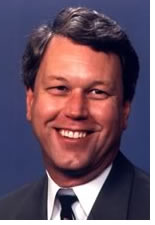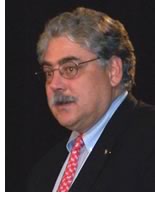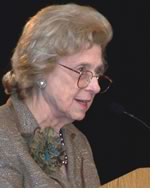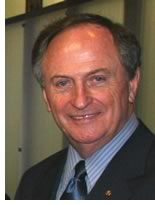

11/2005
Local/state components to sponsor locally directed initiatives for AIA150
AIA component executives and their 232 “champions” rallied in Chantilly, Va., November 6–7, to inspire and be inspired to celebrate the Institute’s “AIA150” sesquicentennial anniversary. The AIA150 champions—selected by their local and state chapters to spearhead the “Blueprint for America” local projects and events that will commemorate the Institute’s 150th year in 2007—spent the two days trading both dreams and level-headed advice about choosing the right kinds of projects and how to get them done.
 “Twelve months and seven weeks stand between us and a great milestone,
a transformational watershed in the history of America’s architects
and, I would argue, the citizens of this nation,” said AIA President
Douglas L Steidl, FAIA, as he welcomed the participants.
“Twelve months and seven weeks stand between us and a great milestone,
a transformational watershed in the history of America’s architects
and, I would argue, the citizens of this nation,” said AIA President
Douglas L Steidl, FAIA, as he welcomed the participants.
Steidl said that he was impressed by the diversity of the champions who had volunteered to bring the celebration to the local components. “You really are the AIA—past, present, and future,” he said.
Designing a legacy
Steidl remarked that since the Institute’s founding in 1857, the
men and women who joined the AIA took us rapidly from a time when there
was no licensing, no standard contract documents, no architecture schools,
no public architecture libraries, and no professional journals to now: “And
in doing so, they created a profession!”
“In 2007, we celebrate their achievement and their legacy. But they would wish us to do more, and we will,” Steidl said. “The men and women who created the AIA would not want us to rest on their legacy; they would want us to create our own, and we will.” He explained that the purpose of the AIA champions was to bring the spirit of advocacy to working collaboratively with citizens from communities all over this nation. “Some of us already have built strong relationships within our towns and cities. The next few days of brainstorming, training, and inspiration will build on those relationships to help us move forward.”
Steidl and subsequent speakers emphasized time and again that AIA150 celebrations must be locally directed efforts. “It’s about the local issues. It must be locally generated, and it must be relevant to your community,” he said. He further suggested the champions keep two overarching goals for the projects in mind: Improving the quality of life and enhancing the value of architects.
Blueprint for America
 George
Miller, FAIA, managing partner of New York City’s Pei Cobb
Freed and chair of the AIA150 program, welcomed the champions and offered
an outline of the events and projects that make up AIA150 on the national
and local levels, and that have been percolating for the last two years:
George
Miller, FAIA, managing partner of New York City’s Pei Cobb
Freed and chair of the AIA150 program, welcomed the champions and offered
an outline of the events and projects that make up AIA150 on the national
and local levels, and that have been percolating for the last two years:
- National Architecture Week, which will first take place April 8–14, 2007
- The 2007 AIA national convention in San Antonio, which will be a celebration of AIA Gold Medalists
- The Center for Architecture: a place—real or virtual—where we can present the history and the knowledge of the AIA to engage architects and the public
- Enhancement of the AIA national headquarters building, perhaps to increase its sustainability
- Raising funds for the preservation of the Octagon House
- Raising resources for scholarships and research that will directly benefit architects.
Miller described the “Blueprint for America” initiative. “There is no right one way to design a blueprint,” he said, but all ways require that architects listen to the community, facilitate and interpret their dreams, envision the future, and document the results. “I can’t stress enough that the blueprints must be community-driven.”
Miller asked the champions to recruit their AIA150 teams before the AIA Grassroots Leadership Conference in February 2006. “Reach out to universities, young architects, emerging professionals,” he advised. “You are the caring and committed individuals who can make the blueprints happen. Let’s prove that AIA architects can and are making a difference.”
 Inspiration
Inspiration
The Hon. Corinne Claiborne “Lindy” Boggs—congresswoman
from Louisiana who succeeded her husband and served eight terms from
1973–1990, chair of both the Joint Committee on Bicentennial arrangements
and the Commission on the Bicentenary of the U.S. House of Representatives,
and ambassador to the Vatican from 1997–2001—offered the
keynote address. After Steidl introduced her as “a role model of
service to the community,” she began by thanking the AIA for “your
remarkable work, day in and day out, and for all of the assistance you
have offered to New Orleans.”
Boggs said she wanted to honor the AIA for its work. “It’s obvious that the AIA will continue its commitment to the profession and the communities it serves.” She talked of her special fondness for the U.S. Capitol, and T.U. Walter’s and other AIA members’ role in its history. “I’ve long loved the building that your founders have created for our country.” She recalled that in the 1970s, while she served in Congress, the preservation community, led by the AIA, helped save the West Front of this American icon, a movement she strongly favored. She reminded the architects that the first committee established by the AIA was the Historic Resources Committee. “I salute and thank the AIA for its role in historic preservation,” she said.
Build the future; preserve the past
Boggs also spoke of her love for her 1795 historic home in New Orleans’ French
Quarter, which was designed after that part of the city suffered from
two very large fires. “Now, the future of my hometown is in great
doubt, she said. “Hurricanes Katrina and Rita were extraordinary
events that changed New Orleans forever with unprecedented damage, estimated
to range from $17–33 billion. We face a great challenge: we must rebuild
our great city.” New Orleans is a great economic hub of shipping,
energy, and fishery; simply put, she said, the nation cannot afford not
to rebuild New Orleans.
Safety, of course, is the first concern, Boggs continued, and it must come in the form of improving the levees and other flood-control systems. It also is imperative that a comprehensive plan to protect the city include rebuilding hundreds of thousands of acres of surrounding marshlands and wetlands to protect the city. As far as the city itself goes, a huge part of its cultural heart has been destroyed or severely damaged, and Boggs said that she hopes that the AIA, as part of the Blueprint for America initiative, will commit itself to helping to rebuild New Orleans. “Preservation of our architecture is an essential part of our heritage . . . We cannot afford to lose our architectural heritage and the fabric that holds it together,” she declared. Any new building must fit into its surroundings, she said.
Boggs is hopeful about the potential outcomes of the Louisiana Recovery and Rebuilding Conference, which the AIA is sponsoring November 10–12 in New Orleans. “You, as architects, understand the importance of identity and strong sense of place,” she concluded. “Let’s construct New Orleans for another 150 years.” After an enthusiastic response from the audience, Steidl presented Boggs with a donation from the Institute to the Foundation for Historical Louisiana in her name.
 The role of champions
The role of champions
It’s an inspiration to see this group gathered for this purpose,
and thank you for being here, said AIA Executive Vice President/CEO Norman
L. Koonce, FAIA, who will lead capital fundraising initiative for AIA150. “What
comes to mind when you think of someone as a champion?” He explained
that when we talk about design, it can refer to a process (a verb) or
product (a noun). “Champion,” he said, is the same kind of
word, and he urged participants to reflect on what “champion” as
a verb entails. “You’ve got to do the first before you can
claim to be the second,” he said.
Koonce told the champions that they would need to be coach, recruiter, diplomat, encourager, cheerleader, and all-around dreamer for their AIA150 projects. “We cannot conceive of what we can do until we share our dreams. We can’t work at odds with each other; in other words, we need to excel in the area of ‘no surprises,’” Koonce said. He advised the champions to select the best teams possible and collectively design their visions carefully, complete with the “playbook” of a strategic plan. “You need to share your dream at least once a day. I challenge you to do that,” he said. “I hope you’ll then expect an epidemic of success.
“It is going to be difficult work,” Koonce acknowledged. “I feel strongly about it; I hope you’ll adopt some of these attitudes. You’ll need help—and you’ll get it. I wish you the best of everything in the important role that you’ve been undertaking.”
Engaging community leaders
The Hon. Jeremy Harris, former mayor of Honolulu and former public director
on the AIA Board, infused the group with community spirit, even though
he wasn’t present in the room. The champions were treated to
a video presentation of Mayor Harris, who said, as mayor for 10 years,
he has developed and articulated a positive image of AIA architects.
He has been surprised that people generally do not see architects as
community builders, “and that’s an attitude I think we
have to change,” he said.
 Harris
believes that the next 10–15 years will be critical to
the development of the country, and indeed the planet. “Who is
going to articulate a vision of communities that are sustainable, and
how are we going to come up with a new agenda for a future that is truly
sustainable?” he asked. He suggested:
Harris
believes that the next 10–15 years will be critical to
the development of the country, and indeed the planet. “Who is
going to articulate a vision of communities that are sustainable, and
how are we going to come up with a new agenda for a future that is truly
sustainable?” he asked. He suggested:
AIA architects can provide that vision and lead people to it. The AIA’s sesquicentennial celebration offers a golden opportunity to demonstrate to the nation that architects are community leaders and builders. Harris said that one of the goals should be building stronger relationships between AIA architects and local governing leaders. For example, he suggested, give the mayor an award honoring something sustainable with which he or she has been involved in your city. Ask the mayor to speak about sustainable design at your awards banquet. If the mayor doesn’t know about it, he or she will have to learn. Use the resulting press coverage as your opportunity to spread your vision in the news.
AIA architects should articulate their community’s vision. Offer to do a charrette on an issue that’s important to the mayor. Hold it on a Saturday—off the record—so that the mayor can raise concerns and fully participate in the design process. Recognize that the end product belongs to the mayor.
AIA architects should be leaders. “This is where you can craft your AIA150 blueprint,” Harris said. Offer to hold a visioning charrette for sustainable design. Invite absolutely everyone—schools, builders, “NIMBYs,” and trades. Use the media to make sure that everyone is invited. Extend the process over one or two months, and remember, this is the mayor’s visioning process.
“All mayors want to do the right thing—they just don’t know how,” Harris concluded. “It’s also about educating the decision makers, and giving them the vocabulary to articulate what they want. Ultimately, you will need to end up as a community leader who can articulate a vision for the community’s sustainable future,” he concluded.
Down to brass tacks
The morning of November 7 found the inspired champions eager to take
part in their training sessions, which started off with a presentations
by Miller and AIA Chief Operating Officer Jim Dinegar on what to expect
in terms of funding and a session on “delivering the message
and engaging the media by Michael Deaver, vice chair international
of Edelman and assistant to the president and former deputy chief of
staff to President Ronald Reagan.
The group then was offered sessions on:
- “Ensuring Success: Engaging Public Candidates and Elected Officials in Issue Forums,” by Ron Faucheux, Esq., the AIA’s team vice president for government advocacy.
- “Freedom by Design,” a volunteer program to help persons with disabilities make their homes more accessible, by Brad Buchanan, AIA, and Trinity Simons.
- “How to Organize and Conduct Visioning Charrettes,” by Bill Lennertz, AIA, National Charrette Institute
- “Planning AIA150 Celebrations,” by AIA Denver President Martha L. Bennett, AIA, and AIA150 Senior Director Robin Lee, Hon. AIA.
The champions have until April 1, 2006, to define their chapter’s Blueprint for America initiative. Contact your state and local components to find out what’s happening and how you can take part in your local initiatives.
Copyright 2005 The American Institute of Architects.
All rights reserved. Home Page ![]()
![]()
 |
||
To
learn more about the history of the AIA and the upcoming sesquicentennial
celebrations being planned for 2007, visit the “AIA150” Web
site.
|
||